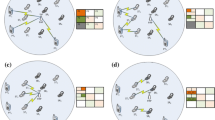Abstract
This paper proposes a spectrum sharing scheme based on Stackelberg game exploiting the SON features of 3GPP LTE-A HetNets. In the game, the MeNB controls and prices the available spectrum resource which the PeNBs can purchase and use to serve the Pico-cell as well as offload some macro-users. Both kinds of nodes try to maximize their own utility which is consisted of user data rates, earning and expenditures on spectrum trading. During the dynamic interaction of the game, the interference coordination features of the LTE-A SON, such as almost blank sub-frames (ABS) of enhanced inter-cell interference coordination (eICIC) and cell range expansion (CRE), are employed so that the change of spectrum allocation can be fully exploited. Simulation results show that the proposed approach can significantly improve the throughput of victim users with slight network total throughput degradation.










Similar content being viewed by others
References
Aliu OG, Imran A, Imran MA, Evans B (2013) A survey of self organisation in future cellular networks. IEEE Commun Surv Tutorials 15(1):336–361
3GPP TS 32.500 (2009) Self-organizing networks (SON); Concepts and requirements (Release 9), V9.0.0
WiMAX Forum, http://www.wimaxforum.org/
Wireless Broadband Alliance, Carrier Wi-Fi Guidelines, http://www.wballiance.com/resource-center/wba-white-papers/. February 2014
3GPP TR 36.902, E-UTRA; Self-configuring and self-optimizing network (SON) use cases and solutions (Release 9), V9.3.1, March 2011
Juan R., Hamied K (2011) Self-organizing networks (SON): self-planning, self-optimization and self-healing for GSM, UMTS and LTE. Wiley
Hu RQ, Qian Y (2013) Heterogeneous cellular networks. Wiley
Hu RQ, Qian Y (2014) An energy efficient and spectrum efficient wireless heterogeneous network framework for 5G systems. IEEE Commun Mag 52(5):94–101
Li Q, Xu Y, Hu RQ, Qian Y (2013) Optimal Fractional Frequency Reuse and Power control in the heterogeneous wireless networks. IEEE Trans Wirel Commun 12 (6):2658–2668
Li Q, Hu RQ, Qian Y, Wu G (2013) Intra-cell cooperation and resource allocation in a heterogeneous network with relays. IEEE Trans Veh Technol 62(4):1770–1784
3GPP R1-104968 (2010) Summary of the description of candidate eICIC solutions, Madrid
Rcz A, Reider N, Fodor G (2008) On the impact of inter-cell interference in LTE. In: IEEE GLOBECOM, pp 1–6
Lee SB, Pefkianakis I, Meyerson A, Xu S, Lu S (2009) Proportional fair frequency-domain packet scheduling for GPP LTE uplink. In: IEEE INFOCOM, pp 2611–2615
Hua Y, Zhang Q, Niu Z (2010) Resource allocation in multi-cell OFDMA-based relay networks. In: IEEE INFOCOM, pp 2133–2141
Lasaulce S, Debbah M, Altman E (2009) Methodologies for analyzing equilibria in wireless games. IEEE Signal Process Mag 26(5):41–52
Harsanyi JC (1967) Games with incomplete information played by Bayesian players, I-III. Manage Sci 14 (3):160–182
Kang X, Liang YC, Garg HK (2011) Distributed power control for spectrum-sharing femtocell networks using Stackelberg game. In: IEEE ICC, pp 1–5
Li P, Zhu Y (2012) Price-based power control of femtocell networks: a Stackelberg game approach. In: IEEE PIMRC, pp 1185–1191
Kang X, Zhang R, Motani M (2012) Price-based resource allocation for spectrum-sharing femtocell networks: a Stackelberg game approach. IEEE J Sel Areas Commun 30(3):538–549
Hamouda S, Zitoun M, Tabbane S (2013) A new spectrum sharing trade in heterogeneous networks. In: IEEE vehicular technology conference (VTC Fall), pp 1–5
Biglieri E, Caire G, Taricco G (2001) Limiting performance of blockfading channels with multiple antennas. IEEE Trans Inform Theory 47(4):1273–1289
ITU-R (2009) Guidelines for evaluation of radio interface technologies for IMT-advanced, TR M.2135-1, International Telecommunication Union (ITU)
Author information
Authors and Affiliations
Corresponding author
Additional information
Project 61471066 supported by NSFC.
Rights and permissions
About this article
Cite this article
Sun, S., Gong, L., Rong, B. et al. A Stackelberg Game Based Inter-tier Spectrum Sharing Scheme for LTE-A SON. Mobile Netw Appl 20, 424–434 (2015). https://doi.org/10.1007/s11036-015-0629-9
Published:
Issue Date:
DOI: https://doi.org/10.1007/s11036-015-0629-9



